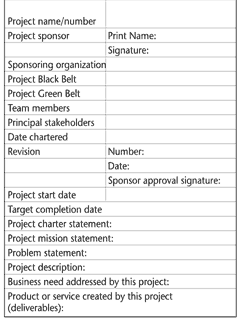Six Sigma's impressive bottom-line results normally flow from Six Sigma projects. Properly defined Six Sigma
projects meet certain criteria: 1. They have clearly defined deliverables. 2. They are approved by management. 3. They are not so large that they're
unmanageable nor so small that they're unimportant or uninteresting. 4. They relate directly to the organization's mission. The project
definition is made explicit in the project charter, which is a document issued by senior management, usually the project sponsor (not the project manager or Black Belt), that provides the project
manager with the authority to apply organizational resources to project activities. The project charter typically includes:  A description of the business need addressed by the project (i.e., the opportunity
or threat presented to the organization that provided the stimulus to undertake the project) A description of the business need addressed by the project (i.e., the opportunity
or threat presented to the organization that provided the stimulus to undertake the project)
 The product that will be produced by the project, that is, characteristics of the value (product or service) that the project will create The product that will be produced by the project, that is, characteristics of the value (product or service) that the project will create
 The relationship between the business need and the product. The product should be described at a high level, but with sufficient detail to support subsequent project planning.
The relationship between the business need and the product. The product should be described at a high level, but with sufficient detail to support subsequent project planning.
 The authorization to apply organizational resources to the project The authorization to apply organizational resources to the project
The problem statement answers the question "Why is it essential that this project
be done now?" It should be specific enough to help the team identify the project's scope and major stakeholders. Although the project team will develop a
work-breakdown structure that will break large projects into smaller subprojects, problems of gargantuan proportions should be subdivided into smaller projects
before assigning them to Six Sigma teams. Senior leadership should put the problem statement in writing.
The project charter should include a statement indicating the mission of the project team and linking the project to the larger organization's mission via the charter.
Avoid the following pitfalls in developing mission statements:  The mission is unclear or undefined (e.g.,"Get a team together to work in the shipping department").
The mission is unclear or undefined (e.g.,"Get a team together to work in the shipping department").
 The mission is too broad (e.g.,"Reduce customer complaints"). The mission is too broad (e.g.,"Reduce customer complaints").
 The problem's nature and severity aren't defined (e.g.,"Are scratches really a big
problem?"). The problem's nature and severity aren't defined (e.g.,"Are scratches really a big
problem?").
 Projects have little or no affect on the organization's success. (Even if they're successful, no one will really care.)
Projects have little or no affect on the organization's success. (Even if they're successful, no one will really care.)
 Missions overlap the missions of other teams (e.g., team A's mission is to reduce
solder rejects, team B's mission is to reduce wave solder rejects and team C's mission is to reduce circuit board assembly problems). Missions overlap the missions of other teams (e.g., team A's mission is to reduce
solder rejects, team B's mission is to reduce wave solder rejects and team C's mission is to reduce circuit board assembly problems).
 Projects improve processes that are already scheduled for extensive redesign or discontinuation. Projects improve processes that are already scheduled for extensive redesign or discontinuation.
 Missions cover a huge system ("patient admitting") rather than a manageable process ("outpatient surgery preadmission").
Missions cover a huge system ("patient admitting") rather than a manageable process ("outpatient surgery preadmission").
 Missions focus on symptoms rather than root causes (e.g., "Reduce touch-up of
defective solder joints" instead of "Eliminate wave solder defects"). Missions focus on symptoms rather than root causes (e.g., "Reduce touch-up of
defective solder joints" instead of "Eliminate wave solder defects").
 Project deliverables are undefined (e.g., "Study TQM" rather than "Reduce waiting time in Urgent Care to an average of 10 minutes"). Project deliverables are undefined (e.g., "Study TQM" rather than "Reduce waiting time in Urgent Care to an average of 10 minutes").
The mission statements of various teams should identify the boundaries between them. Where confusion exists, project sponsors should meet to clarify responsibilities.
There are six steps in the chartering process: 1. Obtain a problem statement. 2. Identify the principal stakeholders.
3. Create a macro flowchart of the process. 4. Select the team members. 5. Identify the training to be received by the team. 6. Select the team leader. Note that these steps are done at a high level. As the project proceeds, the project
team will refine and elaborate on each of these items. The refinement will require frequent communication with the project sponsor. Project charter revisions must be
documented and approved by the sponsor. Project Charters are formal documents that become part of the project plan. Table 1 should help you put together a charter for your Six Sigma project.
Table 1: Boilerplate Project Charter Document
 About the author Thomas Pyzdek is a consultant in Six Sigma. Learn more about Six Sigma at www.pyzdek.com . E-mail Pyzdek at Tom Pyzdek . |